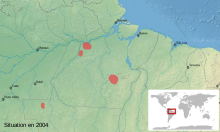Brazil-nut poison frog
| Brazil-nut poison frog | |
|---|---|

| |
| Scientific classification | |
| Domain: | Eukaryota |
| Kingdom: | Animalia |
| Phylum: | Chordata |
| Class: | Amphibia |
| Order: | Anura |
| Family: | Dendrobatidae |
| Genus: | Adelphobates |
| Species: | A. castaneoticus
|
| Binomial name | |
| Adelphobates castaneoticus | |

| |
| Distribution of the Brazil-nut poison frog | |
| Synonyms[4] | |
|
Dendrobates castaneoticus Caldwell and Myers, 1990[3] | |
The Brazil-nut poison frog (Adelphobates castaneoticus) is a species of
Description
The Brazil-nut poison frog is a very small frog with a snout-to-vent length of 18 to 23 mm (0.7 to 0.9 in); females are usually larger than males. The
Distribution
The Brazil-nut poison frog is endemic to the rainforest of central Brazil. It is known from several localities in the state of
Biology
The Brazil-nut poison frog is diurnal and feeds on ants, termites and other small invertebrates.[7] The eggs are laid on the ground where they are guarded by the male. When they hatch, it carries the tadpoles to temporary pools such as water holes in trees and stumps, and water-filled empty nut cases on the forest floor.[5] Here the tadpoles develop rapidly, devouring mosquito larvae, smaller tadpoles, and other creatures that share these ephemeral pools, as well as suitably-sized plant material. This frog may become sexually mature in five to seven months.[5]
Status
The Brazil-nut poison frog is common within its range and the population trend seems stable, although data on its conservation status is somehow insufficient.
References
- ^ . Retrieved 15 November 2021.
- ^ "Appendices | CITES". cites.org. Retrieved 2022-01-14.
- hdl:2246/5075.
- ^ a b Frost, Darrel R. (2018). "Adelphobates castaneoticus (Caldwell and Myers, 1990)". Amphibian Species of the World: an Online Reference. Version 6.0. American Museum of Natural History. Retrieved 2 October 2018.
- ^ a b c d e f KU Herpetology Class (2005-01-13). "Adelphobates castaneoticus". AmphibiaWeb. Retrieved 2014-06-29.
- ^ a b c Lima, Amanda & Gallati, Ulisses (24 February 2011). "Amphibia, Anura, Dendrobatidae, Adelphobates castaneoticus (Caldwell and Myers 1990): distribution extension and geographic distribution map" (PDF). Herpetology Notes. 4: 93–94. Retrieved 6 July 2014.
- ^ a b "Dendrobatidae - Poison Frogs". NHPT. New Hampshire Public Television. Archived from the original on 14 July 2014. Retrieved 6 July 2014.
External links
![]() Data related to Adelphobates castaneoticus at Wikispecies
Data related to Adelphobates castaneoticus at Wikispecies

